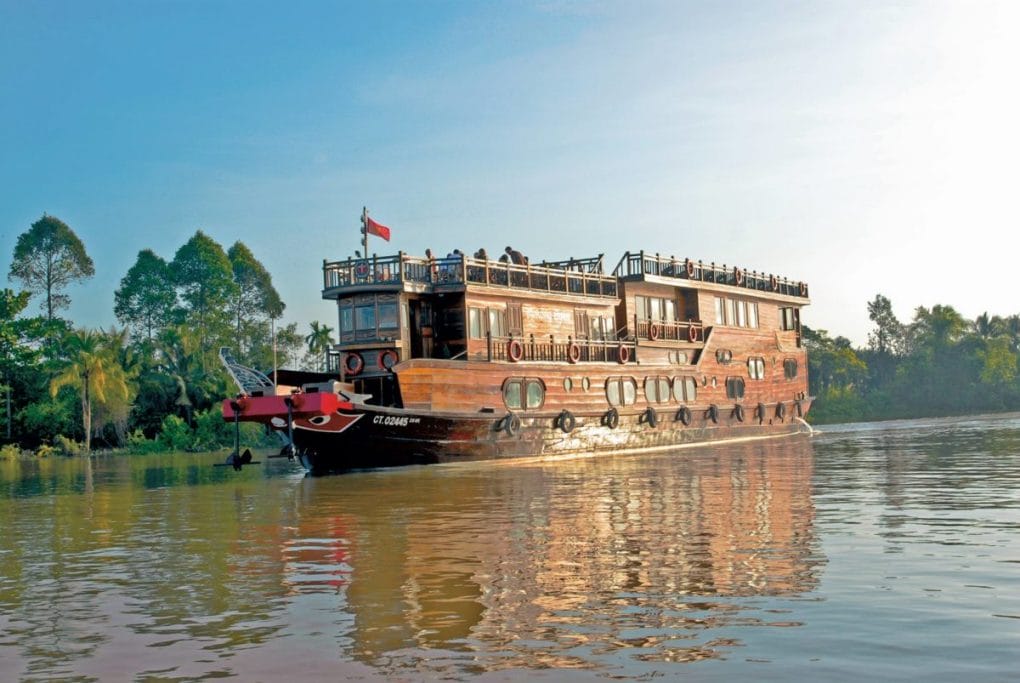Are you planning a family trip to Vietnam? If you’re gearing up for your first trip to Vietnam and haven’t experienced Southeast Asia before, brace yourself for a touch of culture shock. The traffic can be chaotic, English may not be widely spoken, the cuisine might differ from what you’re accustomed to, cleanliness standards vary, and you might encounter the occasional squatty potty. However, we already got your back! This article aims to guide you through the top things you must know, providing valuable insights into navigating the country’s enchanting destinations, understanding local traditions, and ensuring the safety and comfort of your loved ones. If you mentally prepare yourself for the challenges and excitement that lie ahead, you’ll absolutely fall in love with this beautiful, diverse, and amazing country!
1. Arrange your Visa before arriving to Vietnam:
Unlike some neighboring countries like Thailand and Cambodia, Vietnam generally requires visitors from most countries, especially those outside Southeast Asia, to obtain a visa or preapproval letter before entering the country.
Fortunately, the process for obtaining a visa in Vietnam is relatively straightforward. You have the option to use the new eVisa system or get pre-approved for a visa upon arrival. However, it’s essential to note that the visa process can be a bit confusing, given the multitude of online travel agencies competing for your attention. Be cautious of websites that appear official but may not be trustworthy, especially those with “government” or “govt” in their URL.
To simplify the process for your family, it’s recommended to use the official eVisa site maintained by the Vietnamese government: https://evisa.xuatnhapcanh.gov.vn/trang-chu-ttdt
If you’re seeking a 30-day, single-entry, or multiple-entry e-visa, you can go directly to this URL. This ensures a hassle-free experience for you and your family when arranging your visas for Vietnam.
2. FLIGHT IS IDEAL FOR FAMILY TRIP IN VIETNAM
Choosing air travel proves to be the most sensible decision when embarking on a family adventure in Vietnam, given the extensive length of the country from north to south. The journey from Hanoi in the north to Ho Chi Minh City in the south spans over 1,000 miles, a distance that would take approximately 30 hours by car. Even with a month-long vacation, effectively covering the highlights in the southern, central, and northern regions necessitates thoughtful planning that includes incorporating flights.
While buses or trains might seem like cost-effective options, they demand significant time commitments to cover these substantial distances. Thankfully, securing budget-friendly domestic flights is a practical alternative, especially when booked in advance. For families, Vietjet Air is a popular domestic carrier offering affordable flights, though it’s worth noting that it may not always be the most punctual airline. For a more reliable and punctual flight experience, Vietnam Airlines is recommended, ensuring a smoother journey for your family.
3. BE PREPARED FOR THE HEAT (AND THE COLD)
Our Best Selling Tours:
Get ready for a mix of heat and cooler temperatures as you explore different parts of Vietnam with your family. Whether you’re in the southern, central, or northern regions, be aware of the tropical or subtropical climate prevalent throughout the country. If humidity tends to play havoc with your hair or makeup, be prepared for that, especially when venturing outdoors.
Expect some rain, especially if your family are visiting Vietnam from July to November during the summer and autumn months. In the north, winter (December – February) can bring cold temperatures, and places like Sapa might even experience occasional snowfall.
Central Vietnam maintains a consistently warm climate all year round, with summers being particularly hot. This is something to consider if you plan to explore family-friendly destinations like Hue, Hoi An, or Da Nang, where the intense summer heat might make stepping out of your air-conditioned hotel room feel like a significant effort.
Before you embark on your family journey, check the weather forecast for each city you plan to visit in Vietnam. This way, you can plan and pack accordingly, ensuring your family is comfortable and ready for the varying weather conditions you’ll encounter.
4. CROSSING THE STREET CAN BE CHALLENGING:
Walking around in Vietnam can be a bit tricky, especially because of lots of motorbikes on the roads. They don’t always follow the rules and might not stop for people crossing the street. Cars and bikes might go on sidewalks or ignore red lights.
When you cross the road with your family, be careful and walk when there’s a space. The vehicles might not stop, but they will go around you. This is more noticeable in Ho Chi Minh City than in Hanoi. Just know that crossing the street in Vietnam might be different from what you’re used to, so keep your family safe.
5. GET A VIETNAMESE SIM CARD
Even in remote places like Sapa, Halong Bay, and Ninh Binh, you’ll be pleasantly surprised to find a strong Wi-Fi signal in Vietnam. If your phone is unlocked, consider grabbing a Vietnamese SIM card for around $10, and you’ll get a whopping 60 gigs of data. The 4G service is reliable almost everywhere. No need to fuss with upgrading your home cell service to an international plan for your family Vietnam trip!
Now, when it comes to choosing between Viettel, MobiFone, and Vinaphone, our top pick for tourists is Viettel. It’s hands down the best Vietnam SIM card option.
6. ALWAYS WEAR A HELMET ON MOTORBIKE, IT’S THE LAW
In December 2007, Vietnam made an important rule to make roads safer. They said everyone must wear a helmet while riding a motorbike. This was a big deal because Vietnam had a lot of accidents, and many people were getting hurt. Vietnam was the second-highest country in Southeast Asia for accidents, with 24.5 out of every 100,000 people having accidents. Since almost everyone uses motorbikes (95% of registered vehicles), this rule was very important for safety. Now, you’ll see most people in cities wearing helmets.
This rule has helped a lot. An organization called the AIP Foundation thinks that since they made this rule, it stopped 15,000 people from getting killed and 500,000 people from getting hurt in the last 10 years. If your family visit Vietnam and ride a motorbike, even if you rent it or use one of those popular Grab bikes, you must wear a helmet. But don’t worry – if you use a Grab bike, they usually have an extra helmet for you.
7. USE GRAB, NOT TAXIS
When you’re traveling around Vietnam with your family, try using Grab instead of regular taxis. Grab is like the Uber of Southeast Asia. Just download the app, and you can find a driver whenever you need a ride. It might take a bit longer than getting a taxi, and sometimes the ride might be canceled, but it’s easier than figuring out taxi prices beforehand. And it’s much cheaper! You can either use your credit card or pay with cash for each ride. Usually, it won’t cost more than $2 USD to get around the city. Trust us, using Grab during your family trip to Vietnam will help you save time, money, and avoid unnecessary problems!
8. DOLLARS & DONG:
When your family is traveling around Vietnam, it’s good to have both US Dollars and Vietnamese Dong. People usually accept US dollars for things like tours, transportation, and hotels that tourists use. But for local places like restaurants, shops, and markets, it’s better to use Vietnamese Dong. You can get Dong from an ATM when you arrive, but having some US dollars is important, especially for paying for your family’s visas.
If you can choose to pay in Dong or Dollars, picking Dong is usually cheaper. So, it’s smart to have a mix of both currencies for your family’s trip in Vietnam. This way, you can easily handle different parts of your journey without any problems.
9. DON’T BE AFRAID TO HAGGLE – THIS IS A PERFECTLY NORMAL CUSTOM IN VIETNAM.
Don’t shy away from haggling – it’s a perfectly normal practice in Vietnam and an integral part of the culture, especially when dealing with tourists. Whether you’re in markets, independent shops, or even beauty and massage salons, feel free to test your negotiation skills. You can either ask for a “better price” or state the amount you’re willing to pay. Keep in mind that in restaurants and bars, prices are usually fixed, unless it’s happy hour! Having a good grasp of haggling is key, making it one of the essential things to know before heading to Vietnam.
Pro tip: If they let you leave their shop without further discounting the price, you might have pushed too hard. You can always return later and accept the best price they initially offered.
10. LEAVE NON-ESSENTIAL VALUABLES AT HOME
To ensure the safety of you and your family during the trip, it’s advisable to leave non-essential valuables at home. This involves refraining from bringing favorite jewelry, high-end designer items, or expensive tech gadgets. While it might be tempting to include them, consider opting for more budget-friendly versions tailored for your family travels. For instance, rather than carrying Bose headphones, explore more economical alternatives available on platforms like Amazon. Embrace the simplicity of streamlining your possessions while in Vietnam to avoid attracting unnecessary attention to you and your family.
11. TIPPING ETIQUETTE IN VIETNAM: A GESTURE OF APPRECIATION
In Vietnam, tipping is not obligatory or part of the customary practice, but it is always welcomed. Demonstrating your gratitude through a small tip is a thoughtful way to acknowledge the services provided by waiters, drivers, and other service workers. While tipping might not be a norm for you, it holds great significance for those who assist you during your travels. Additionally, tipping plays a role in encouraging excellent service and is deeply ingrained in the tourism industry across various Intrepid destinations.
To facilitate tipping, it’s recommended to carry small notes of the local currency. It’s best to avoid tipping with coins, very small denomination notes, or those that are dirty or torn, as this could be considered disrespectful. If your tour leader provides exceptional service throughout your journey, you may also consider tipping them. The amount is entirely a matter of personal preference, with a common guideline ranging from US$2 to US$4 per person per day. Of course, you have the flexibility to tip more or less based on your assessment of the service quality and the duration of your trip. It’s crucial to remember that tipping is not mandatory and should only be given when you receive outstanding service.
10. ARRANGE & BOOK YOUR TOUR/ADVENTURE ACTIVITIES IN ADVANCE!
Feel at ease and don’t stress about planning every detail of your trip in advance. In every noteworthy town like Hanoi, Hoi An, and Ho Chi Minh City, there’s a travel agency conveniently situated around every corner. For a family-friendly travel experience, consider VietLong Travel agent and explore their tailored family tour (Link). This 12-day Charming Vietnam Family Tour is crafted to ensure a delightful and memorable journey for you and your loved ones.
























